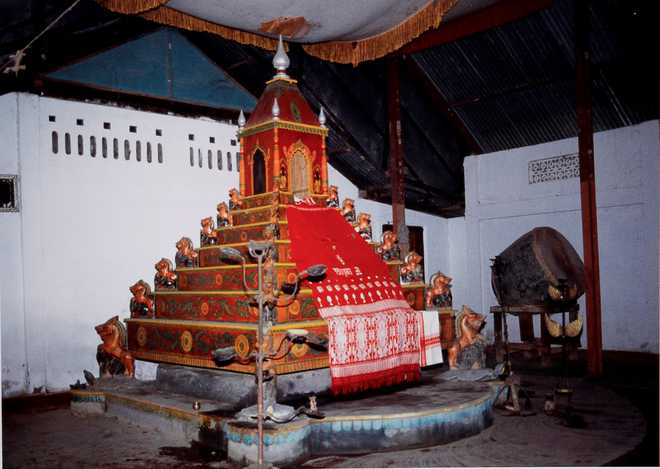B.N.Goswamy
Gems and wrought gold, never sold; brought for me to behold them
Tales of far magic unrolled — to me only, he told them
With the light, easy laugh of dismissal, ‘twixt story and story
As a man brushes sand from his hand, or the great dismiss glory.
— From Rudyard Kipling’s
A Song in the Desert
There is a story behind these verses that needs to be told, for it is unlikely that many in our part of the world would know about it. In the background of it is a great textile — a whole textile tradition, in fact — that came from Assam some 400 years or more ago. Vrindavani Vastra is how the textiles were named, redolent of the groves in which Krishna, that great enchanter, used to play on his flute at one time.
Traditionally, the Vastras are associated with one of the greatest figures in the history of Assam: Srimant Sankara-deva (1449-1568), ardent devotee of Krishna, who brought into those parts the message of ‘Neo-Vaishnavism’ and established Krishna worship in a manner and on a scale unknown before him. Legends have grown around Sankara-deva’s life and career: how, for instance, he weaned large sections of populace away from their tribal ways which included, prominently, Shakta beliefs; founded satra-s in which nothing but Krishna-worship was practised; installed in those satra-s tall, tiered simhasana-s on which were placed, as objects of devotion, no images but only manuscripts of the most sacred of Vaishnava texts, the Bhagavata Purana. Among his converts to Krishna worship were the Cooch-Behar king and his yuvaraja — the latter named Chilarai — and these two wanted the Vaishnava saint/scholar to acquaint them with the lila-s of Krishna in Vrindavana in a visual form. Sankara-deva decided to have a textile woven with the theme of Krishna’s various exploits. What was woven, according to tradition, was a vast textile, some 180 feet long, produced on a draw-loom in the highly complex lampas technique, featuring in brilliant colours repeat patterns of figures, all centreing upon Krishna. This great textile was given the name Vrindavani Vastra. What became virtually a school of textiles came to be founded in Assam.
The original Vrindavani Vastra, woven in the lifetime of Sankara-deva and possibly under his personal supervision, appears not to have survived, but textiles in the same tradition, and rigidly following both the same technique and the same range of themes, continued to be woven in the times that followed. The various incarnations of Vishnu, and the exploits of Krishna, were all there to see in highly stylised form in these woven strips of figured, silken cloth: the killing of different demons; the quelling of the serpent Kaliya, the sun-bird Garuda as the vehicle of Vishnu; and so on. It is estimated that close to 20 fragments of textiles of this kind, going back to the 16th and 17th centuries, have survived, but they are all scattered now, being mostly in museums in London, Paris, Los Angeles, Newark, Wales, and, of course, in the British Museum.
To the Vastras as such and on their technique, on which Rosemary Crill of the V&A did such distinguished work, I will go back at another time. Here my intent is only to draw attention to the recent great show at the British Museum of the vastra-fragments in its collection, and of the history of the travels of these assembled strips about which Richard Blurton has so engagingly written. The British Museum ‘piece’, if it can be so called, is large, being 9.37 meters in length and 2.31 meters in height, and makes for sensational viewing. But how it came to be in the collection of the Museum is a story.
The piece, clearly woven in Assam, was discovered in Tibet in the days of the Younghusband expedition in the early years of the 20th century. It was found in the Buddhist monastery at Gobshi, had been pieced together there, and was acquired by a special correspondent of the Times, Perceval Landon. How it was acquired — “whether purchased, bartered, given or stolen” — is not known, but Landon, friend of Rudyard Kipling who remembered him in the verse above, later gifted the vast piece to the British Museum where it was inventoried in 1904 as “a large hanging woven in designs of monsters and charms” of Tibetan origin.
The travels, both physical and mental, of this great textile have been extraordinary. From Assam to Tibet to London; from a Vaishnava setting to a Buddhist monastery; from being a hanging filled with ‘monsters and charms’, back to being valued as an object worthy of respect both as a sacred textile and as a specimen of uncommon skills. It is a long journey.
Unlock Exclusive Insights with The Tribune Premium
Take your experience further with Premium access.
Thought-provoking Opinions, Expert Analysis, In-depth Insights and other Member Only Benefits
Already a Member? Sign In Now











